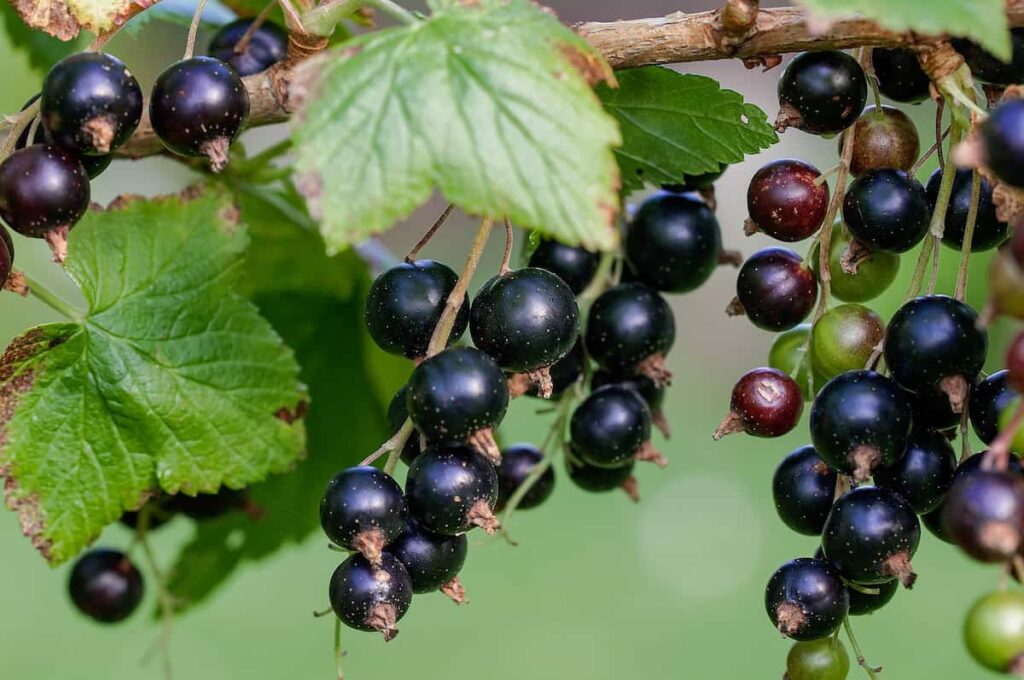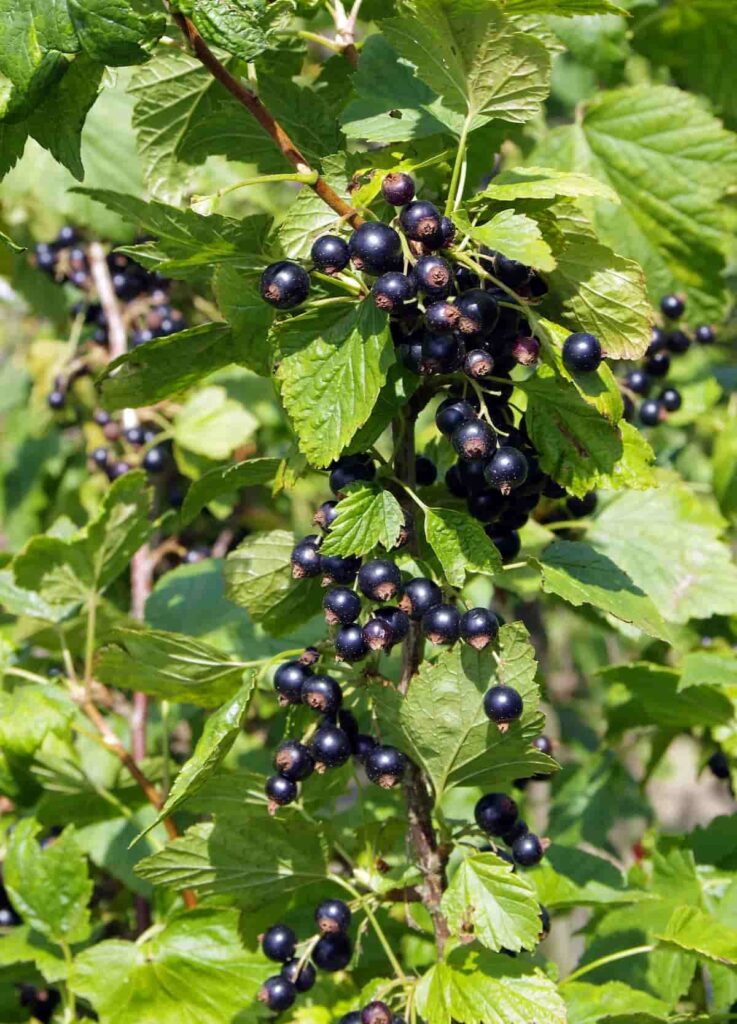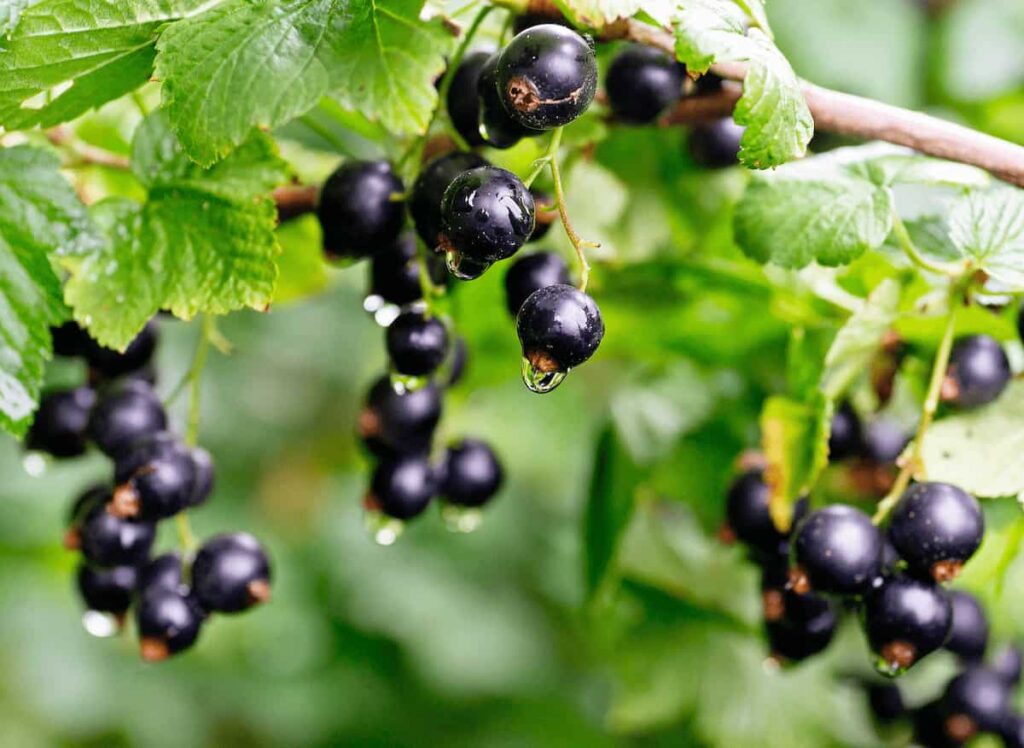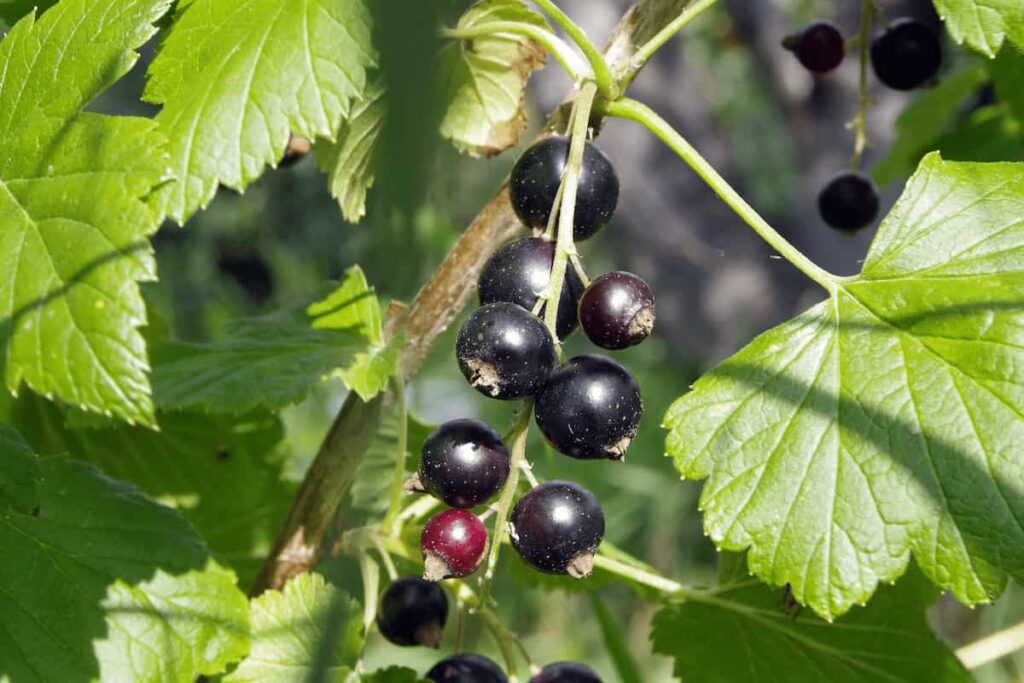Currants are perfect for fruit salads and jams. Tart and delicious Blackcurrants pack a ton of vitamins and other nutrients, making them a great addition to your garden. In addition, they are relatively easy to grow, requiring little care once planted. When you choose an ideal planting location and set them up for success with nutrient-rich soil, you’ll have a steady supply of Blackcurrant throughout the summer months.

It is easy to grow the Blackcurrant from seed. They are unusual plants and grow in almost any garden. Still, paying attention to where you plant your Blackcurrant is important. Blackcurrant shrubs are relatively easy to grow and care for, making them a great option for those who want to enjoy fresh, homegrown fruit without hassle.
How to grow Blackcurrants from seed to harvest
How long does it take to grow Blackcurrant from seed?
- It takes at least two years to produce good standard Blackcurrant, so the price is much higher than a normal bush. Blackcurrants are easier to grow and are more tolerant to heavier soils than other Currant shrubs. If Blackcurrant bushes are well-fed and watered, you can harvest the fruit a year after planting.
- Blackcurrants propagated reliably from both seed and hardwood cuttings. However, seed-grown shrubs take two to three years to produce fruit, while cutting propagated specimens produces berries in just one to two years if grown in moist, lightly shady conditions.
Germinating Blackcurrant seed
You can start Blackcurrant seeds at the end of winter, about two months before the last spring frost. Choose the seeds and throw away someone with obvious signs of damage or mold. Soak Blackcurrant seeds in lukewarm water in a bowl for 24 hours. Throw away any seeds floating on the surface even after the soaking period. Pick the seeds that sink to the bottom. You should cover the Blackcurrant seeds in moistened sphagnum moss and place the bundle inside a sealable plastic bag. Keep the bag inside the refrigerator for three months to cool the seeds.
After Blackcurrant seeds are cold stratified, prepare growing containers. Fill the 4-inch pots with equal parts of a mixture of medium grit sand, loam, and compost. You should sow one Blackcurrant seed in each pot at a depth of 1/4 inch. Spray the water to settle the soil around the seed. You can place the pots indoors in a cold frame or against a lightly shaded, south-facing wall.
Maintain moderate humidity in the upper inches of soil while Blackcurrant seeds germinate. Allow the surface to dry slightly between the watering to ensure that the soil does not dry below the surface. Watch out for the first seedlings about a month after the Blackcurrant seeds are sown. Once they have developed a set of mature leaves, move the plants to the bright, sheltered area of the garden. Grow Blackcurrant shrubs under partial shade during the summer months. Provide one or two inches of extra water each week. Transplant them into the final position in the fall.
In case you missed it: How to Grow Peach From Seed to Harvest: Check How this Guide Helps Beginners

Sun requirement for growing Blackcurrants
- Plants tolerate light shade and can be grown in the ground or pots. Blackcurrants grow best in places that receive the morning sun and afternoon shade or the dappled shade of the day. Unlike many other vegetables, you don’t have to put a Blackcurrant in full sunlight. They prefer places with plenty of morning sunshine and afternoon shade, which protects them from the scorching heat of the afternoon.
- Blackcurrants grow best in some shade. As far as soil conditions go, well-drained soil that retains moisture is ideal. Blackcurrants will be badly affected if the soil is filled with water, but they prefer a constant source of moisture.
Do I need 2 Blackcurrant bushes?
Only one plant can provide a generous crop of berries. You should not need two or more varieties for cross-pollination and fruit sets. The flowers are somewhat self-compatible, but styles and anthers are physically separated into individual flowers. However, all cultivars need cross-pollination of insects to set up a good crop.
Fertilizer requirement for growing Blackcurrants
- Blackcurrant bushes require plenty of water and feeding, especially if the container grows. In spring, you should feed with pelleted chicken manure or other high potash fertilizer and add a thick mulch. Keep grass-free during the growing season, and when the fruits start to mature, net your plants to protect them from birds.
- Currant plants are heavy feeders. Work the compost in the soil before planting to give plants a healthy start. Annual top dressings of composted manure are also beneficial. If the plants are not vigorous, lightly broadcast about 113 to 226 grams of 10-10-10 fertilizer per plant.
- A composted material rich in nitrogen, such as well-rotted manure, makes an excellent fertilizer for Currants. Since composted materials release their nutrients more slowly than artificial fertilizers, apply a few shovels per plant in late autumn.
In case you missed it: Blackberry Growing Tips, Techniques, and Secrets

Do Currants need a trellis?
Blackcurrant bushes are more vigorous than redcurrants. They are fuller and straight with straight branches and become 5 to 6 feet longer and wider. Different varieties also grow at different heights. The height of 1.5 meters is about average. Some Blackcurrant shrubs at this height need some help for some branches when they become fruit. Currant shrubs will need a trellis in full sunshine to shade for flourishing. Five feet tall and ½ inch diameter bamboo stack by each cordon (1 per Gooseberry plant, or 3 per Currant plant), connected to the top and bottom wires using the pole clip.
Water requirement for growing Blackcurrants
From fruit sets to harvesting, the Currant plants require 1 inch of water per week. After an initial watering, a soaker hose or drip irrigation system can maintain a proper water supply. Currants require a steady supply of water for their shallow roots. Immediately after planting, water the soil until the tops are soaked 6 to 8 inches.
After the first year, it is most important to add extra water from June to September when shrubs are most active. Mature bushes have an extensive root system, so you’ll need to make a large puddle under the bush when watering. The more water the bush gets, the juicier the berries are.
Pruning overgrown Blackcurrant bushes
It is important to prune Blackcurrant shrubs regularly to help keep plants healthy and increase their yield. Pruning will differ slightly from new plants if you have a mature plant. Pruning Currant shrubs is necessary to maintain the plant’s shape and remove any diseased material to keep the interior part of the plant open. Head back, the one-year-old shoots to the next growing point to force branching.
The Blackcurrant crop was best at strong young growth made the last year, so they are usually grown as a multi-stem shrub, with stems growing from the base. To encourage new stems, they need to be pruned annually in winter. Cut them in winter (between November and March), and remove old, dead, and crowded branches so that there is room for new canes to grow. Remove the old growth directly after harvesting and tie the new growth to supporting wires or canes.
In case you missed it: Best Fertilizer for Blackberries: Homemade, Organic, Compost, Natural, Liquid, NPK Ratio, How and When to Apply

Why is my Blackcurrant not fruiting?
Blackcurrant shrubs require about 9 hours of sunlight daily to bear fruit well. Blackcurrant shrubs require about 9 hours of sunlight daily to bear fruit well. The Blackcurrant is a very light-sensitive fruit tree, so it won’t produce many fruits if they don’t get enough sunlight.
How do you know when Blackcurrants are ready to pick?
While you can pick Blackcurrants all summer, they’ll taste best a week after they ripen. Collect your Blackcurrant when it’s sunny because any moisture can make your Blackcurrant mold faster. Blackcurrants are ready to pick up when they’re black and shiny but are still strong. Harvest whole trusses instead of individual berries. Fully ripened Currants have the characteristic color of a variety (red, white, or black) and are slightly soft and juicy. For jelly and jam, harvest the Currants before the berries are fully ripe.
Soil requirement for growing Blackcurrants
- Currants prefer cool, moist, well-drained places. Avoid poorly drained, wet soil and hot, dry sites. Choose sites with good air movement to discourage fungal diseases, such as powdery mildew. Blackcurrants tolerate many soil conditions but prefer well-drained, moisture-retentive conditions. Blackcurrants prefer full sun but will tolerate a lighter shade.
- They require much organic matter and well-drained soil with a pH between 5.5 and 7.0. Currants grow well in the sun or partial shade and appreciate the afternoon shade in a warm climate. Blackcurrants prefer well-drained but moisture-retentive soils, although they will withstand most other soil conditions. Avoid places prone to cold winds or late frosts, damaging flowers and reducing the crop.
In case you missed it: How to Grow Lilies from Bulbs to Harvest: Check How this Guide Helps Beginners

Can you start Currants from cuttings?
Wait until the plant has lost all its leaves, and remove the strong, healthy stems from the bush’s base. Cuttings don’t require special treatment; they must take root in well-drained soil in a sheltered border or cold frame. You can even propagate them in a pot.
Blackcurrant can be propagated by hardwood cuttings taken from newly planted certified virus-free plants from mid-autumn to winter. Take a 12-inch cutting from a year-old stem and have what you need for the new plants. Just stick them to the ground in early spring and let nature do the rest of the work. This cutting is often done when pruning the plant, which is usually done in early spring.
Growing Blackcurrants in pots
Blackcurrants generally do not perform well in containers long-term due to their size and growth habit. If they start performing poorly, transplant them into the ground. The roots of the Currant plant do not grow deep. The roots of the Currant plants do not mind growing in a narrow space. Plant Currants in an organic potting mixture. Keep the soil evenly moist. Feeding plants an all-purpose fertilizer.
Growing them in containers has many benefits, especially in small gardens and cold climates. The container must be at least 2 to 2 .5 feet wide and 20 to 24 inches deep for Blackcurrant. There should be many drainage holes at the bottom of the container, as good drainage is necessary. Place a 1-inch-thick layer of gravel or stones at the bottom and fill the container with organic matter-rich soil such as well-rotted manure, compost, etc. Adding well-balanced NPK fertilizers with a gradual release of nutrients can help plants.
The best time to plant Blackcurrants
The best planting time is during the dormant season from late October to March, but it is best to avoid planting in the middle of winter if the soil is too wet or frozen. Containerized plants can be planted throughout the year. Seeds can be sown in sandy compost at any time of the year and thinly covered with sand or grit.
In case you missed it: How to Grow Durian Fruit from Seed to Harvest: How this Guide Helps Beginners

How much space does a Blackcurrant bush need?
- Allow enough space between plants because they require good air circulation, and you’ll need to get between them to pick fruit. So at least 1 meter, preferably up to 1.5 meters. An average Blackcurrant bush will need a gap of 5 meters, and it will grow similarly in height. If you lack space, look for a new compact type of ben sarek that can only be 3.5 inches apart and is also shorter in growth.
- Blackcurrants don’t grow well with companion plants, so it’s best to plant them alone. However, they tolerate other Currant types, including white Currant and redcurrant, and wormwood is a major exception.
When should you harvest Blackcurrants?
- Blackcurrants tend to ripen in July, some of the latest varieties will bear fruit in August, and some very early varieties may ripen by the end of June. Blackcurrants ripen at the start of summer so that you can harvest them throughout the season. During spring, the Blackcurrant is pruned, so only fruiting shoots remain. Collect your Blackcurrant before autumn begins and your shrub enters its dormant season from October to April.
- Blackcurrant fruits are ready to pick up mid to late summer (July and August) and perform at their best about seven days after the blue turns black. They can be collected individually, or if you want them to stay fresh for a while, you can cut them out as a whole truss.
Conclusion
Before you add Currant bushes to your yard, check with a local nursery if you’re allowed to grow them in your area. Currants are limited in some areas because they help complete the life cycle of the fungus that causes white pine blister rust, a disease that can destroy nearby pine trees and other crops.
Blackcurrants are particularly sensitive, but there are disease-resistant varieties that may be safe to plant in areas where restrictions are in place. Blackcurrants are great for beginners because their growth is easy, even though they require generous feeding and careful pruning to get a good harvest.
- Gardening Techniques in Planting Vegetables
- Where to Place Indoor Plants in Your Home
- How to Grow Tomatoes Organically at Home: A Comprehensive Guide
- Organic Gardening on a Budget: Low-Cost Methods and Materials
- Gongura Seed Germination and Planting Methods
- Cabbage Seed Germination and Selection
- Broccoli Seed Germination and Selection
- Asparagus Seed Germination and Variety Selection
- Seasonal Flower Gardening: Best Practices for Spring, Summer, Fall, and Winter
- How to Grow Hibiscus from Flower
- Plantation Ideas for Home Decoration: A Beginners Guide
- Flower Garden Designs and Layouts for Beginners
- Planting and Spacing Techniques in Papaya: A Beginner’s Guide
- Growing Gold: Essential Techniques for Planting Pineapples
- How to Make Kalanchoe Plant Bushy: Home Remedies and Solutions
- 11 Reasons Why Your Gardenia is Not Blooming: Home Remedies and Solutions
- Eco Elegance: The Guide to Designing a Drought-Tolerant Landscape
- Gardening on a Slope: Strategies for Hillside Landscaping
- Nourish and Flourish: Top Organic Mulches for Thriving House Plants
- Everything You Want to Know about Indian Mogra Flower: Discover Uses and Growing
- Green Thumb Success: Expert Tips for Cultivating Greenhouse Pumpkins All Year Round
- Maximize Growth & Flavor: The Ultimate Guide to Companion Planting in Herb Gardens
- How to Control Rhododendron Problems Naturally: Home Remedies and Organic Ways to Fix Them
- Natural Magic: The Remarkable Benefits of Cinnamon for Plants
- Best Steps to Revive Dying Tulip with Natural and Organic Treatment
- 10 Reasons Why Your Angel Trumpet is Not Blooming: Remedies and Treatment
- How to Fix Periwinkle Leaf and Flower-Related Problems: Natural Remedies and Solutions
- How to Fix Zinnias Leaf and Flower Problems: Discover Natural and Home Remedies
- Organic Steps to Induce Lemon Tree Flowers: A Comprehensive Guide
- Bloom Booster: Crafting the Perfect Homemade Bougainvillea Fertilizer
- Optimizing Growth: A Guide to Applying NPK Fertilizer for Potted Plants
- 10 Best Homemade Fertilizers for Rubber Plant: DIY Recipes and Application Method
- How to Boost Female Pumpkin Flowers: Effective Steps for More Flowers and High Yields
- Transform Your Indoor Garden: Top Benefits of Pink Salt for Houseplants
- 10 Best Homemade Fertilizers for Peacock Plants (Calathea): Easy DIY Guide
- Unlock Blooms: 9 Reasons Why Your Potted Chrysanthemum is Not Blooming